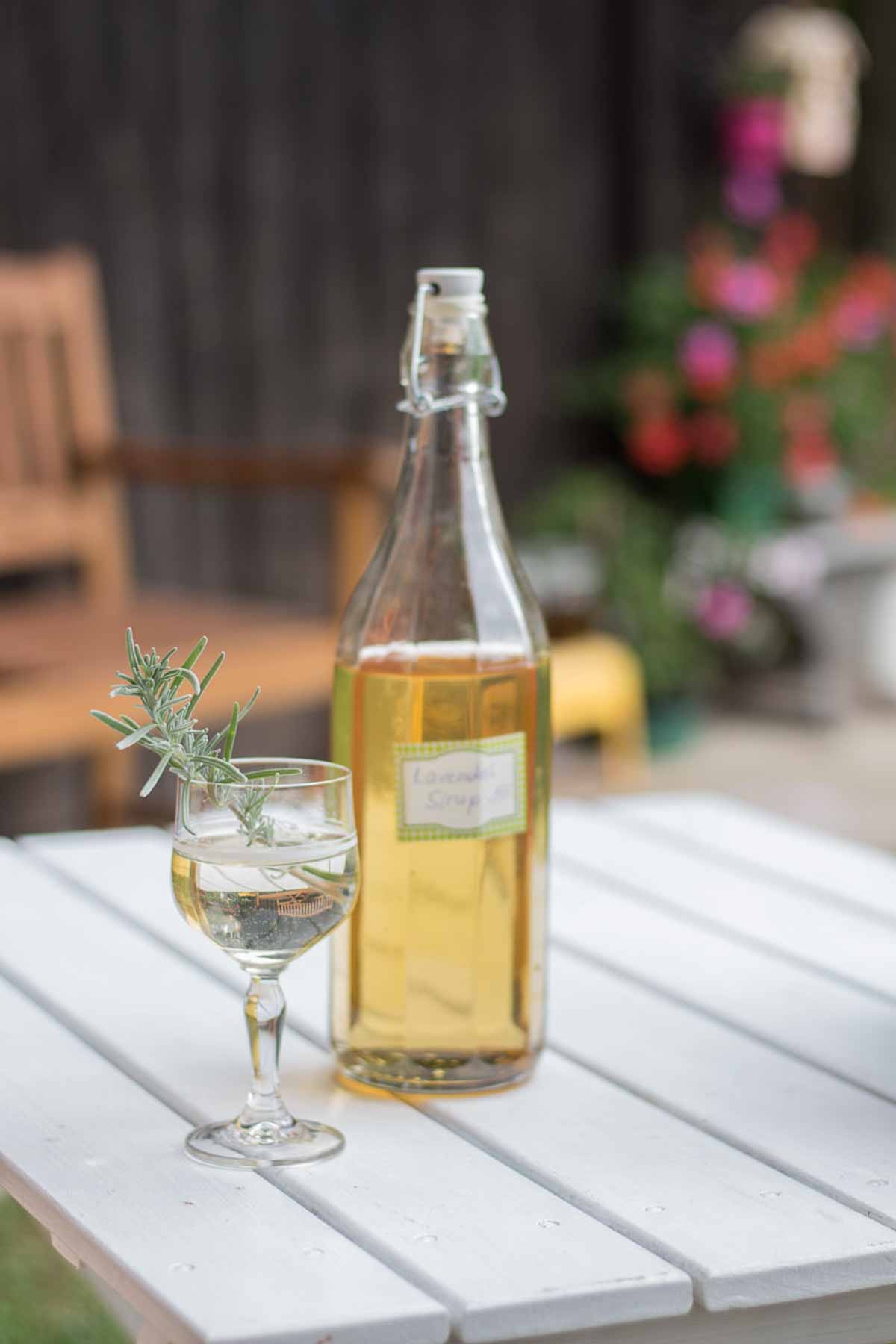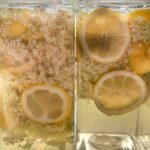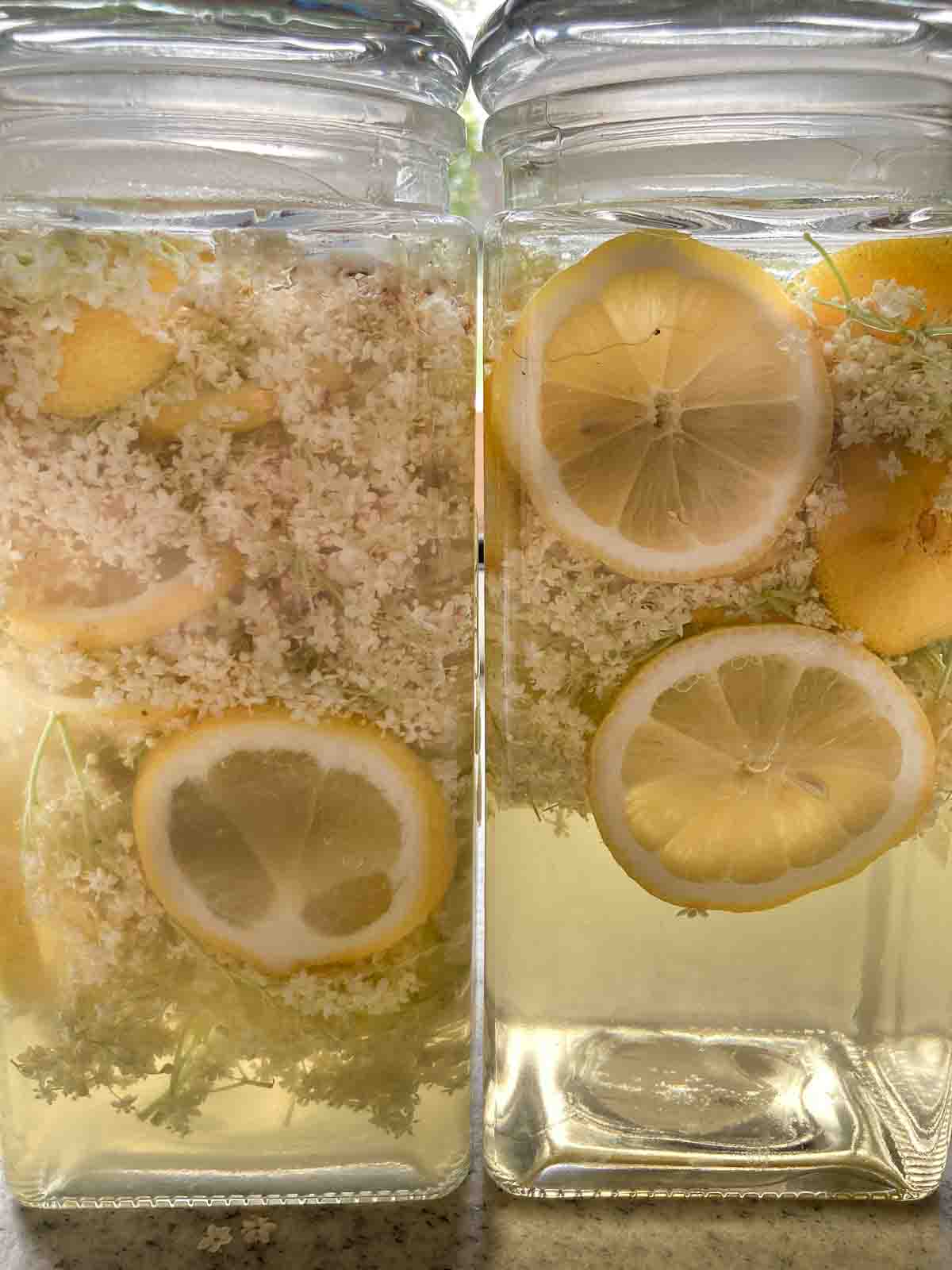Making syrup from herbs and flowers is really easy! Here I have collected the most important basics for the production of your own personal homemade syrup with a herbal infusion.
The information in this article is mainly for syrup made from herbs and flowers (such as lavender, elderflower syrup, peppermint, for example).
For syrup of fruits and berries, there are a few other rules that I do not cover in my article.

Jump to:
- Sterile bottles
- How to make an infusion for syrup from herbs and flowers
- How much sugar for syrup from herbs and flowers?
- How much citric acid for syrup from herbs and flowers?
- Do I need to use citric acid for my syrup?
- Storage and Shelf Life
- Do I need to boil the syrup before bottling?
- Canning - Do I need to boil the syrup after bottling?
- Equipment for canning syrup
Sterile bottles
The bottles must be sterile, otherwise the syrup does not last as long and can get moldy. There are several methods, for example:
- Pour some hot/boiling water over the bottle
- Boil in a pot (use grid inlay or cloth on the bottom of th epot so the glasses don't get to hot)
- Put in an oven at about 80-120 °C (180-240 °F) for 20 minutes - I have not tried that yet, but it is also recommended for flip-top bottles with rubber stopper
- sterilize in steam cooker or canning machine
You need to pour the syrup into the bottles the moment after cooking, so it stays sterile. For this purpose use a funnel so that the closure is not contaminated.
The bottles must be sealed immediately after filling with the hot syrup. This way, a vacuum is created, which should lead to a shelf life for 1 year or longer.

How to make an infusion for syrup from herbs and flowers
In order for the aromas and ingredients of the herbs or flowers to pass into the syrup, you need to store them in water or sugar syrup for a while, depending on the recipe.
In doing so, you should make sure to:
- use clean containers
- cover the herbs/flowers with a plate or similar, so that they remain in the liquid
- store the mixture in a cool place (cellar, closet, refrigerator).
Depending on the recipe, this mixture sometimes needs to be stored for a few days, but sometimes for a shorter period of time.
In some recipes the herbs/flowers are stored only in water in some already in the sugar syrup.
To make sugar syrup, heat water, sugar and possibly citric acid (or lemon juice) in a pot until all mixed.
Some recipes require to add the herbs to the syrup while it is still hot. Other recipes require a "cold infusion", where you add the herbs as soon as the syrup has cooled down.
You can leave the mixture in the pot, but be sure to close the pot with a clean lid to prevent additional germs from entering. You can also transfer the mixture into extra sterilized containers.
After a few days of storage at a cool place (cellar, fridge, cool room), the herbs/flowers will have released their aroma to the liquid and they can be strained! (Again, work with sterile equipment).
Depending on the recipe and necessary shelf life, boil the syrup before bottling.

How much sugar for syrup from herbs and flowers?
Syrup of herbs and blossoms can be made with a ratio of 1:1 - this means you use 1 liter of water for every 1 kilogram of sugar. (About 4+¼ cups of water to 5 US cups of sugar.)
Lots of syrup recipes even require a ratio of 1:1.5, which means 1 liter of water to 1.5 kilograms of sugar (About 4+¼ cups of water to 7+½ US cups of sugar.)
When making syrup for the first time I got a bit scared off of the large amounts of sugar needed. But the fact is, after all, that sugar is one of the reasons syrup can be stored for such a long time.
To keep it short, sweeteners, birch sugar or stevia can not directly substitute for sugar.

How much citric acid for syrup from herbs and flowers?
In addition to sugar, most recipes for syrup also contain citric acid. Citric acid provides an acidic environment and thus prevents the proliferation of bacteria and fungi.
Most syrup recipes recommend at least 20 grams of citric acid per 1 liter of water. (~2 tablespoons of citric acid to 4+¼ cups of water)
However, many recipes specify 40-60 grams of citric acid per liter of water. (~4-6 tablespoons of citric acid to 4+¼ cups of water) This way, the syrup has a more sour taste which fits well to certain herbs and flowers. (see elderflower recipe, for example.) A higher amount of citric acid is supposed to increase shelf life of syrup. (But you don't want to overdo it with citric acid either.)
You can get citric acid at the pharmacy or in the baking departments of well-stocked supermarkets. There is also syrup sugar available, where the citric acid is already contained in the right scale.
Citric acid is an artificial industrial product and should not be confused with the juice of real lemons.
Do I need to use citric acid for my syrup?
No, citric acid is not necessary to make a long-lasting syrup. The sugar already gives the syrup a long shelf life. However, citric acid is helpful and can be especially useful if the syrup is made in a cold infusion and not boiled again before bottling.
The juice of one squeezed lemon (~ 100 ml) replaces about 20 g of citric acid.
This means, if you make syrup with 1 liter of water (~4+¼ cups), you can add between 100-300ml of lemon juice instead of citric acid. (100 ml is a bit less than ½ cup)
If citric acid is not used, special care should be taken to work (extra;) hygienically and boil the syrup before bottling for a longer shelf life.
Storage and Shelf Life
If the bottles are sterile and you did everything right, and store your treasure in a dark and cool place, the syrup keeps for at least 1 year. Perfect storage place would be in a cool basement. When the bottle is opened once, you should keep it in the fridge and use within a few days.
Do I need to boil the syrup before bottling?
Boiling the syrup kills possible germs in the syrup and ensures a longer shelf life.
However, some of the aroma of some sensitive herbs can get lost in the process. In some recipes, the syrup is bottled cold directly after being strained. However, this does not guarantee such a long shelf life. (If you work cleanly and have enough acid in the syrup, however, it can still last a long time, there is just a little more risk that the syrup will spoil).
Canning - Do I need to boil the syrup after bottling?
It is not mandatory to boil the syrup after bottling, but it will help to make it last longer because it will kill the germs that got into the syrup, the bottles or bottle caps during bottling.
To boil the bottled syrup, place an inlay grid in a large pot so that the bottles are not directly at the bottom of the pot. Then place the bottles in the pot and pour in water until the bottles are about ¾ covered. Slowly bring to a boil and simmer at a low temperature for about 30 minutes.
Alternatively, you can use a canning machine or the canning function of your steamer oven.
Equipment for canning syrup
Canning syrup is no fun if you don't have the right equipment - believe me, I'm talking from years of excruciating experience! In addition to bottles with caps, a glass lifter is especially handy for lifting hot bottles or jars out of the hot water. Funnels and strainers of the right size are also a must.
Bottles for syrup
Once a bottle is opened, the syrup doesn't last so long anymore. Therefore when it comes to bottles for syrup, it pays to get smaller ones.
Jar lifter
I used to not have a jar lifter and making syrup or jam was always a terribly soggy and finger-scalding affair because of it! So I really recommend this tool to you 😉
Funnel
The funnel for filling syrup should ideally be made of metal, so that you can sterilize it together with the bottles.
Sieve
The sieve should fit directly onto the funnel. If you are making cold syrup that will not be boiled before or after bottling, the strainer ideally should be from metal so that it can be sterilized as well.
Inlay Grid for pots
An iinlay grid is needed for the pot in which the syrup bottles or jam jars are sterilized with hot water before and/or after bottling. The glass bottles should not be placed directly at the bottom of the pot, because otherwise the glass gets too much direct heat and can shatter.
As an alternative to canning in a pot, you can use an automatic canning machine or the canning function of the steamer.


Ich freu mich über deine Rückmeldung zum Rezept in den Kommentaren!